![]()
![]()
![]()
Use LEFT and RIGHT arrow keys to navigate between flashcards;
Use UP and DOWN arrow keys to flip the card;
H to show hint;
A reads text to speech;
41 Cards in this Set
- Front
- Back
|
What is the difference between Epstein pearls, Bohn's nodules and dental lamina cysts? |
Inclusion cysts appear as small white or gray lesions on the mucosa, alveolar ridge and hard palate, and are present in 75% of newborns. All three types – Epstein’s pearls, Bohn’s nodules and dental lamina cysts are asymptomatic and are usually shed within the first three months of life: * Epstein’s pearls may be found on the mid-palatal raphe of the hard palate. |
|
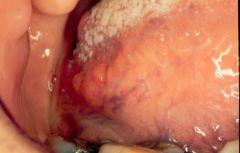
Describe this lesion and give differential diagnoses.
|
Hyperplastic foliate papilla
Normal lymphoid tissue along the lateral border of the tongue.
Ddx: fibroma, pyogenic granuloma, hamartoma, choristoma |
|

Describe this lesion and give differential diagnoses. |
Oral lymphoepithelial cyst
Pale yellowish white nodule of entrapped epithelium within lymphoid tissue.
Ddx: soft tissue abscess, lipoma, sialolithiasis, tonsillar concretions |
|
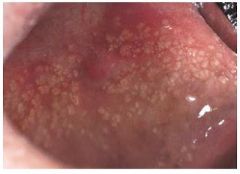
Describe this lesion and give differential diagnoses. |
Fordyces granules
Yellowish papules of ectopic sebaceous glands.
Ddx: pustules or scar |
|
|
List 2 associations with fissured tongue. |
Geographic tongue, Down syndrome, Melkersson-Rosenthal syndrome |
|
|
What is pathognomonic of leukoedema? List 3 differential diagnoses. |
-Diminishes when cheek is streched (bilateral presentation)
Ddx: linea alba, cheek biting keratosis, white sponge nevus |
|
|
What is a syndrome associated with bifid tongue? |
Oro-facial-digital syndrome I |
|
|
What are paramedian lip pits and what syndrome are they associated with? List 2 differential diagnoses. |
-Congenital invaginations of the lower lip -Often associated with Van der Woude syndrome -Ddx: draining mucocele, median lip fissure, scar from lip piercing |
|
|
List 4 potential causes of macroglossia. |
-Congenital (hemangioma, lymphangioma) -Hereditary (Down syndrome, mucopolysaccharidosis) -Inflammatory (angiodema) -Traumatic (hematoma) -Neoplastic (tumor) -Endocrine (acromegaly) |
|
|
List 4 potential problems associated with macroglossia. |
-Airway obstruction, drooling, difficulty eating, speech, malocclusion, cosmetics, crenations/ulcerations of the tongue |
|
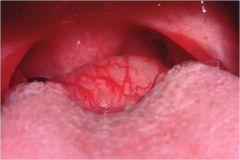
Describe this lesion and give differential diagnoses. |
Lingual thyroid
Ectopic thyroid tissue in the tongue, significance: most lack normal thyroid tissue
Ddx: lymphangioma, hemangioma, lymphoid hyperplasia |
|
|
List 4 signs of a vascular malformation? |
-Thrill, bruit, warmth, pain, bleeding, ulceration, tooth mobility
E.g. Hemagioma, lymphangioma |
|
|
List 4 findings in Sturge-Weber angiomatosis. |
Seizures, mental disability, hemiplegia, ocular defects, vascular malformation, facial Portwine stain that follows the trigeminal nerve, calcification of the cerebral cortex |
|
|
List 4 oral findings in Sturge-Weber angiomatosis. |
Pyogenic granuloma, gingival hyperplasia, bleeding, alveolar bone loss, hypervascular mucosal changes |
|
|
What syndrome is associated with hemangiomas? |
PHACE syndrome: * Posterior fossa –These are brain malformations that are present at birth. * Hemangioma – The hemangioma usually covers a large area on the skin of the head or neck (greater than 5 cm). The term "segmental" is sometimes used to describe these hemangiomas. * Arterial lesions – Abnormalities of the blood vessels in the neck or head. * Cardiac abnormalities/aortic coarctation – These are abnormalities of the heart or the blood vessels that are attached to the heart. * Eye abnormalities. |
|
|
List 4 complications of a hemangioma. |
-Recurrent bleeding and infection, ulceration and scarring, facial deformity, ocular disease, interference with function or airway obstruction |
|
|
What is the Kasabach-Merritt phenomenon? |
Serious coagulopathy with vascular tumors and thrombocytopenia. |
|
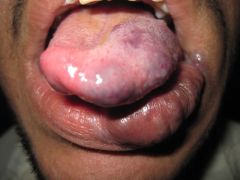
Describe this lesion and give differential diagnoses. |
Lymphangioma
-Congenital hamartoma of lymphatics -Ddx: hemangioma, granular cell tumour |
|
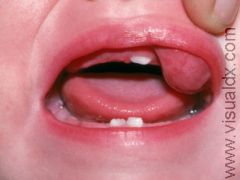
Describe this lesion and give differential diagnoses. |
Neonatal alveolar lymphangioma
-Translucent fluctuant swelling that resolves spontaneously -Ddx: congenital epulis, eruption cyst, dental lamina cyst |
|
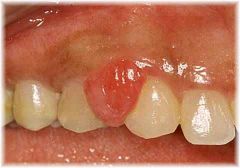
Describe this lesion and give differential diagnoses. |
-Red, ulcerated reactive lesion -Sites: gingiva>lips>tongue>mucosa -Variants: pregnancy tumor, pulp polyp, epulis
Ddx: Soft tissue abscess, hemangioma, foreign body, peripheral ossifying granuloma, peripheral giant cell granuloma |
|
|
List 3 causes of tongue trauma in infants and young children. |
-Riga-Fide disease, seizure disorders, incorrect use of a pacifier, cerebral palsy, Lesch-Nyhan syndrome, Tourette's syndrome |
|
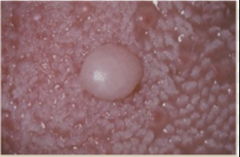
Describe this lesion and give differential diagnoses. |
Giant cell fibroma
-Fibrous hyperplasia of unknown cause
-Ddx: papilloma, irritation fibroma, oral warts |
|
|
List 4 human papilloma virus induced oral lesions. |
- Squamous papilloma, verruca vulgaris, condyloma accuminatum, Heck's disease, multifocal epithelial hyperplasia, oropharyngeal squamous cell carcinoma |
|
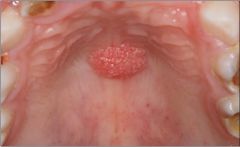
Describe this lesion and give differential diagnoses. |
HPV induced oral lesions:
Squamous papilloma (HPV 6, 11): may be pink white or red, solitary, tx with surgical removal, no malignant potential
Verruca vulgaris (HPV 2, 4, 6, 40): stippled pink or white, usually multiple, tx with surgical removal, no malignant potential
Condyloma accuminatum (HPV 6, 11, 16, 18): sites can be anogenital and oral mucosa, coalescing pink nodule with malignant potential |
|
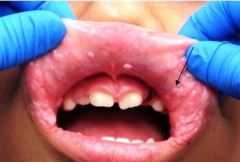
Describe this lesion and give differential diagnoses. |
Heck's disease (multifocal epithelial hyperplasia)
-HPV 13, 32 -Multiple soft plaques or nodules, pink or white in appearance -Risk factors: HIV, poverty, malnutrition, poor hygiene |
|
|
List 4 findings associated with neurofibromatosis type 1. |
-Cafe-au-lait spots, subcutaneous neurofibromas, Lisch nodules, axillary freckling, opitic glioma, osseous lesions, CNS disorders
-Oral findings: enlarged mandibular foramina and canals, oral neurofibromas, enlarged fungiform papillae |
|
|
List 4 oral findings in Ehlers-Danlos syndrome. |
-Periodontal disease, Gorlin's sign (tongue touches nose), oral bleeding, delayed healing, pulp stones, short roots, prominent cusp tips, hypoplastic enamel |
|
|
List 4 medical conditions associated with Down syndrome. |
-Congenital heart defects, increased incidence of acute lymphoblastic leukemia, atlanto-axial instability, cognitive disability, short stature, immune dysfunction, GI anomalies |
|
|
List 4 oral findings associated with Down syndrome. |
-Relative macroglossia, microdontia/conical teeth, oligodontia, class 3 malocclusion, fissured tongue, increased risk of periodontal disease, delayed eruption or overretained teeth, abnormal palate, abnormal root, enamel hypoplasia |
|
|
What are mucopolysaccharidosis disorders? |
Metabolic disorders that lack the enzymes to process glycosaminoglycans
E.g. Hurler, Hunter, San Fillipo, Marquio |
|
|
List 4 oral findings of Hurler syndrome |
Macroglossia, spacing of teeth, gingival hyperplasia, anterior open bite, unerupted teeth, (also short stature and decreased IQ) |
|

What syndrome is associated with these findings (see image) |
-Beckwith-Wiedemann syndrome (microcephaly, macroglossia, umbilical hernia), severe hyperglycemia and renal anomalies |
|
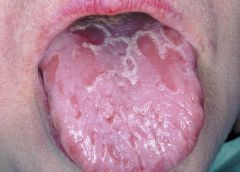
Describe this lesion and give differential diagnoses. |
Benign migratory glossitis (geographic tongue or erythema migrans)
-Oval red patches with white borders that move around -Ddx: candidiasis, contact allergy, traumatic erosion, erosive lichen planus |
|
|
List 4 causes of glossitis. |
Anemia, vitamin B deficiency, candidiasis, oral allergies, diabetes, xerostomia, hypothyroidism, idiopathic |
|
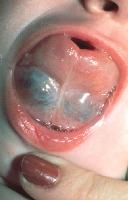
What is this mass and list 4 differential diagnoses? |
Mucuous retention in oral floor, unilateral and fluctuates in size, involves submaxillary or sublingual gland
Tx: excision or marsupialization
Ddx: hematoma, hemangioma, salivary gland tumor, dermoid cyst, cellulitis |
|
|
What is the most commonly involved gland with sialolithiasis? List 3 differential diagnoses. |
Submandibular gland (Wharton's duct, opening near midline of the floor of the mouth)
Ddx: lipoma, oral lymphoepithelial cyst, soft tissue abscess |
|
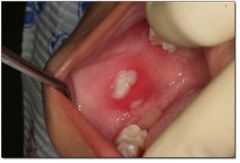
List 3 differential diagnoses for this lesion. |
-Traumatic ulcer, aphthous ulcer, contact allergy, HSV ulcer (orofacial herpetic infection) |
|
|
List 3 types of candidiasis and their differential diagnoses. |
Common oral microorganism: candida albicans Increased susceptibility with long term abx, corticosteroids and drugs that cause xerostomia
-Pseudomembranous: mucosal sloughing, plaque coated tongue -Hyperplastic -Erythematous: mucosal burn, benign migratory glossitis, traumatic erosion, contact allergy
-Tx: nystatin or other antifungals |
|
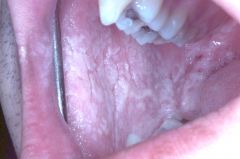
Describe this lesion and list 3 differential diagnoses. |
White sponge nevus Persistent condition more prominent in adolescence
Ddx: frictional keratosis, leukoedema, hyperplastic candidiasis, hereditary benign intraepithelial dyskeratosis (also affects eyes) |
|
|
Describe oral lesions found in lupus erythematosis. |
Prevalence is 25%, sites: lip, palate, buccal mucosa and gingiva
Oral lesions mimic lichen planus and atypical gingivitis |
|

What is a syndromes associated with these findings? |
Darrier-White disease (Dyskeratosis follicularis) -Cutaneous lesions: red, pruritic papules on body, face and scalp -Warty appearance and foul odour -Oral lesions in 15-50%: white papules, cobblestone |

